Watching, Waiting, Praying
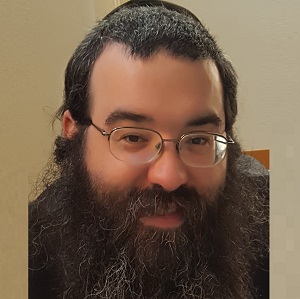
On-site report from Surfside, Florida
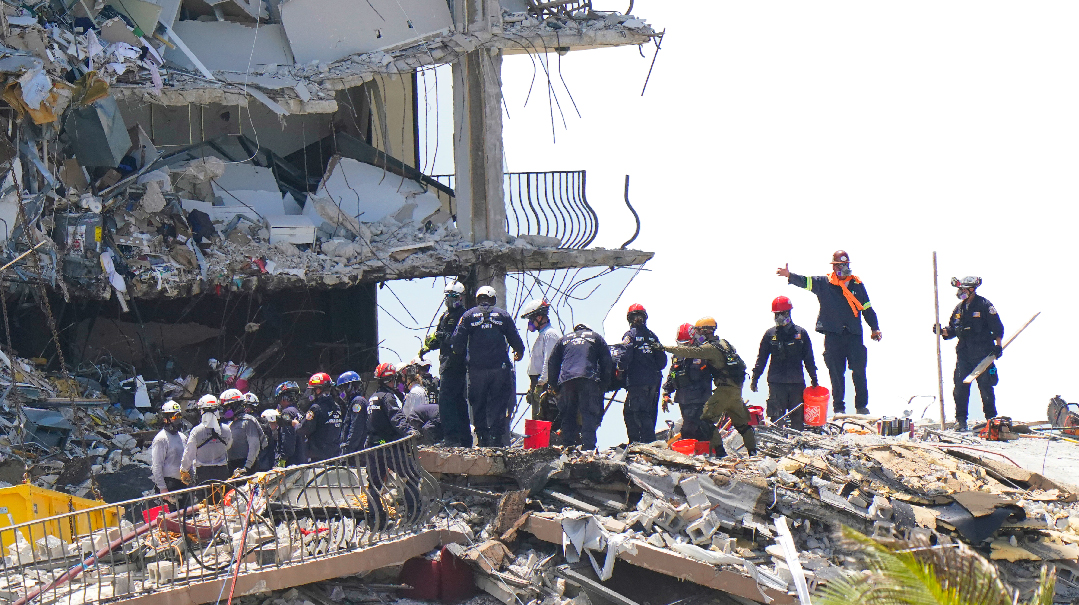
By Yochonon Donn, Surfside, Florida
Photos: Carlos Chattah, AP Images
Surfside is a sunny town now cloaked in the dark garment of unfathomable agony and interminable waiting. Days after a massive apartment complex mysteriously gave a series of shudders and imploded, this Miami suburb of 5,700 residents has been transformed.
Much of Collins Avenue, the miles-long first main boulevard off the beach, containing dozens of beachfront hotel entrances, restaurants, and lots of shopping, is now blocked off, filled instead by hundreds of emergency vehicles flashing red, blue, and white lights, yellow crime scene tape, and dozens of white parasols where members of the international media spend their days waiting for things to happen.
As I walk down the avenue, people stop and offer their prayers. Neon signs declaring “Prayers for Our Surfside Neighbors” are ubiquitous. A short, elderly woman with a Christian symbol dangling from her neck stops me, cups her palms heavenward, and urges me to “pray, pray.” As I enter the Grand Beach Hotel, housing family members of those missing, a tall man with a graying goatee and a cap identifying him as a veteran of the Iraq and Afghanistan wars walks up the steep incline to the hotel. He says he’s a Baptist pastor and wants to pray with the relatives.
A town dotted with picturesque high-rises and gigantic apartment complexes, Surfside is about a third Orthodox Jewish and a third Hispanic. Many of its residents are retired and don’t hesitate to smile and wave to me as I pass their morning tea groups in the wooden gazebos that are everywhere. Collins Avenue is a one-way, three-lane avenue that bisects the entire neighborhood and heads north toward Bal Harbour; to the left are single- or double-story buildings, streets with no traffic lights, and a no-sidewalk road that has a countryside feel. To the east, dozens of apartment buildings and hotels appear to scrape the sky — separating the peninsula from the great blue Atlantic Ocean right behind.
And the ground zero of it all is the former Champlain Towers South, at 8777 Collins Avenue. The complex — a trio of towers — has 136 units, most of them occupied full-time. The north and south towers were erected in 1981, while the east tower went up in 1994. All three were built by the same developer. The catastrophe is the nation’s first unexplained building collapse in nearly half a century, ever since a federal Drug Enforcement Administration building in Miami suddenly imploded, killing seven people. It was that disaster that led the county to require inspections of buildings that are over 40 years old. The Champlain Towers had just begun work to comply with the 40-year review.
Last Wednesday night will remain indelible to one elderly woman. She spoke to her granddaughter, Malky Weisz, a Lakewood resident, who, along with her husband Benny, was visiting her father, Harry Rosenberg, a resident of the Champlain Towers.
“She told me I was the best bubby in the world,” the grandmother recalled tearfully.
The Weiszes and Mr. Rosenberg are among the 150 people missing after several days of trying to dig through tons of cement and debris, as 12 floors pancaked to the ground just a few hours after Mrs. Weisz spoke to her grandmother.
At about 1:15 a.m. early Thursday morning, some residents were awakened by a crackling sound, pipes swishing around and water rushing. Outside, a thick cloud of white dust was enveloping the area. Several people, such as Moshe Candiotti, sensed danger and ran out. Most remained, many of them asleep. Some were still attempting an escape, shining a flashlight along the stairwell, as a surveillance video showed. One woman was calling her husband about a sudden crack she noticed in the outdoor pool below her window when the phone line went dead. Another woman called police to demand that the “construction” going on stop immediately since it was keeping her two young children from sleeping. Suddenly, she and her husband saw part of the building going down, got their kids out of their beds, and ran for their lives. But the staircase directly outside their unit was collapsing, so they decided to run to the other side of the building and find another staircase. They escaped in the nick of time. Dozens of their neighbors weren’t so lucky.
About three minutes after the mysterious sounds began, estimates Rabbi Mark Rosenberg, head of the Florida chapter of Chesed Shel Emes and chaplain of the North Miami Beach Police Department, the gigantic building gave a final shudder and partially collapsed. Within eight seconds, 55 of the 136 units in the complex cascaded down into a “concrete pancake.”
A massive search and rescue operation has been underway since last Thursday. Initially, crews rescued 35 people who were trapped in the building and two others from beneath the rubble, but as the days pass, chances of finding survivors grow less and less likely. Rescue teams are continuing to use heavy machinery and power tools to clear the rubble from the top and tunnel in from below. As of press time, ten bodies have been pulled from the debris, and over 150 people remain missing. The search for them “could go on for months,” search and rescue teams say.
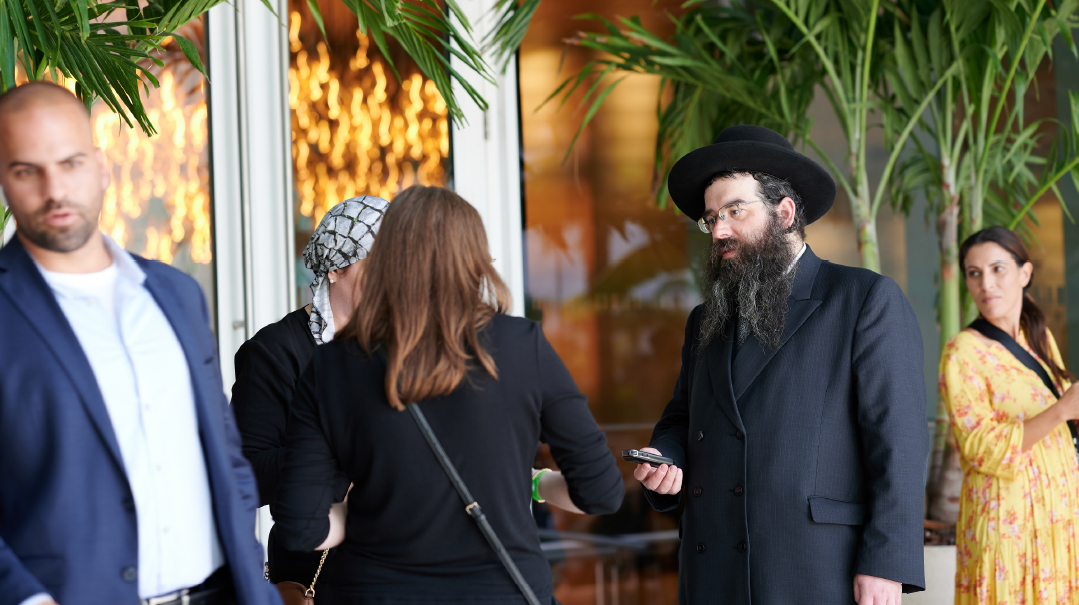
Mishpacha’s Yochonon Donn joins family members on their days-long vigil. It soon sank in that this was turning into a recovery mission
Crawl to Safety
“I don’t think people understand the magnitude of what happened,” Chesed Shel Emes’s Mark Rosenberg said as we spoke on a hotel porch overlooking the pool.
He kept his phone in hand, charging via wireless charger, as calls kept coming in. Rosenberg has been credited for informing families of developments in a way that has kept them as collected as possible under the circumstances.
“People are saying, ‘This is 9/11.’ But this is a different story. This is about apartments that are still in one piece, and the people are not there. One of the Israeli team members tells me, ‘Mark, I don’t get it, I’m working here for eight hours, and I still didn’t find anything?’ This is very serious.”
About a quarter of those missing are Jewish, according to Israel’s consul general to the Florida area. Many of the others are Hispanic or South American.
Sharon Schechter, 60, was one of those who made it out on time. She lived on the 11th floor of the building. She was asleep shortly before 2 a.m. when she felt the building begin shaking.
“I realized, ‘Oh, my G-d! Where is the building? There’s no building!’ “ she told a local reporter. “We were screaming, ‘Help! Come get us! We are here! Come get us!’ ”
She somehow made her way out of the pitch-black building holding her dog.
“I feel like I’m mourning every minute for someone in that building,” Schechter said later, adding, “I’m hoping that there’s a reason why I survived — a bigger picture.”
The daughter of Arnie and Myriam Notkin, an elderly couple (87 and 81) who lived in the collapsed tower, was getting nonstop phone calls from her parents’ landline since Thursday night — 16 as of Shabbos. But when she picked up, all she heard on the other line was static, followed after two seconds by a dial tone.
“We were all sitting there in the living room, my whole family,” Jake Samuelson, a grandson, told the Local 10 news, adding that the Notkins lived on the third floor of the tower. “We were just shocked, but we kind of thought nothing of it because we answered, and it was static.”
But for some reason, the calls kept coming. Was it a fluke, or was someone trying to make contact?
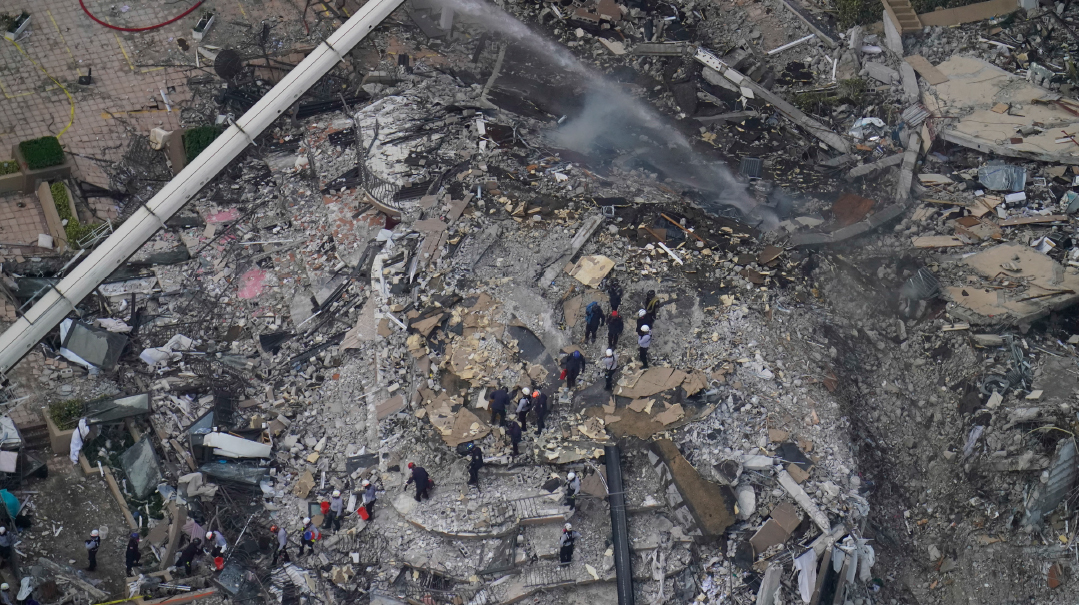
Maybe They’re Hiding
The collapse threw the entire neighborhood, as well as Jews around the world, into a state of anxiety. Officials expedited visas for any relative who wished to fly in from Israel or South America, and the second floor of the Grand Beach Hotel became a makeshift headquarters, with the local Jewish community pouring in an abundance of food — nonstop pizza and drinks — as well as a staff of trained trauma counselors.
As the hours turned into days, the vicissitude of not knowing proved too much for many family members. When they were briefed on the latest discoveries on Shabbos afternoon, one family member turned toward Rabbi Sholom Ber Lipskar, rabbi of the Chabad “The Shul” nearby, and asked if the recovery of a body part meant that she could begin sitting shivah. The woman was immediately shouted down by others, who loudly insisted that they not give up hope in finding their loved ones alive — perhaps they escaped the collapse by hiding in a crevice, they suggested. The relatives pointed to noises emerging from the rubble as evidence that people might still be there.
“It was such a contradictory experience,” says Chaya Hentchy Friedman, a Boro Park trauma counselor who happened to be in Miami with her sister Goldy Weill when the building collapsed. She stayed with the families throughout Shabbos, listening to them and providing whatever comfort she could muster.
“While some people were asking questions that were more pointed toward the future, other people were getting very bothered by those questions. They were saying, ‘What do you mean? We can’t give up hope. Let’s turn the conversation toward, “Are they doing enough? Are the Israelis here? Maybe they should be adding more people to the search teams.” ’ People were getting very agitated.”
According to Mrs. Weill, family members were saying things like, “Go over there now! What are you standing here? Start picking up the rubble! We’re begging you, move quicker — find my daughter now!”
The first day or two, searchers fully expected to be able to rescue people alive. It was on Shabbos when it sank in that this was turning into a recovery mission. When a fire began smoldering at the site, temporarily halting the search, it heated up the metal and concrete to unbearable temperatures.
“That’s when everything changed,” Rosenberg said. “I visited the families’ gathering place, called the ‘reunification area,’ several times. In a room to the side, a young man appeared to be taking the emotional pain very hard. His head was down on the table and Dr. Norman Blumenthal, the chief trauma specialist at Ohel who had just arrived from New York, was talking to him. Receptionists were at a desk taking DNA samples with cotton swabs. Another table, with the words ‘counselors’ written in block letters, offered therapy for anyone who wanted.”
Governor Ron DeSantis has been a steady presence at the hotel, arriving in a wail of emergency sirens and flashing lights every day. The state’s two senators have also visited, Marco Rubio on Shabbos and Rick Scott on Sunday. The mayors of Miami, Surfside, and Bal Harbour are constants there.
One frum man, Yochanoan, was milling around the outskirts of the crowd. He had arrived the previous Wednesday from Forest Hills, Queens, to visit his friend David Siegel. He showed me several texts the two exchanged, including one in which they discussed the prospects of learning b’chavrusa.
“But since Thursday he hasn’t answered me,” Yochanan says, worry seeping from his tone. “And they don’t have him on the list. Is this normal?”
Cause and Effect
What caused the collapse? Theories flew thick and fast in the first days after the tower suddenly imploded. Some suggested it was the salty ocean air that caused the concrete and steel to erode. Other blamed the unsteady earth. One Florida resident said state authorities would normally require annual inspections and a recertification of the building every 40 years due to its proximity to the ocean.
The first 40-year recertification had just begun, and workers were repairing the roof, though nothing that would threaten the building’s integrity, said Kenneth Direktor, an attorney for Champlain Towers South Condominium Association, which constructed the towers.
“I’ve never seen anything like this,” Direktor said. “Never. Nothing even close. And there are a lot of buildings around Florida that have already done their 40-year certification and needed extensive work, but nothing like this ever happened. Which is why I don’t think we’re anywhere near a point where we can develop an understanding of what caused this, or find any correlation between the 40-year certification and what happened to this building.”
Officials also downplayed a suggestion that the construction of an apartment complex nearby would have caused the disintegration.
A video of the collapse showed it imploding rapidly in a way similar to a bridge collapse. Officials were forging in their recovery work, but said that the particular manner of implosion would usually mean that there was little hope for survivors.
On the day of the collapse, the Florida International University posted a study by one of its professors who found signs that the land in the area has been steadily sinking into the earth.
The study, conducted by Professor Shimon Wdowinski and published in the April 2020 edition of the journal Ocean & Coastal Management, identified the Champlain Towers South as a location where the land was gradually caving in. But he added that the erosion in and of itself was not a likely cause of a building’s collapse.
“When we measure subsidence or when we see movement of the buildings, it’s worth checking why it happens,” Wdowinski said in his study. “We cannot say what is the reason for that from the satellite images, but we can say there was movement here.”
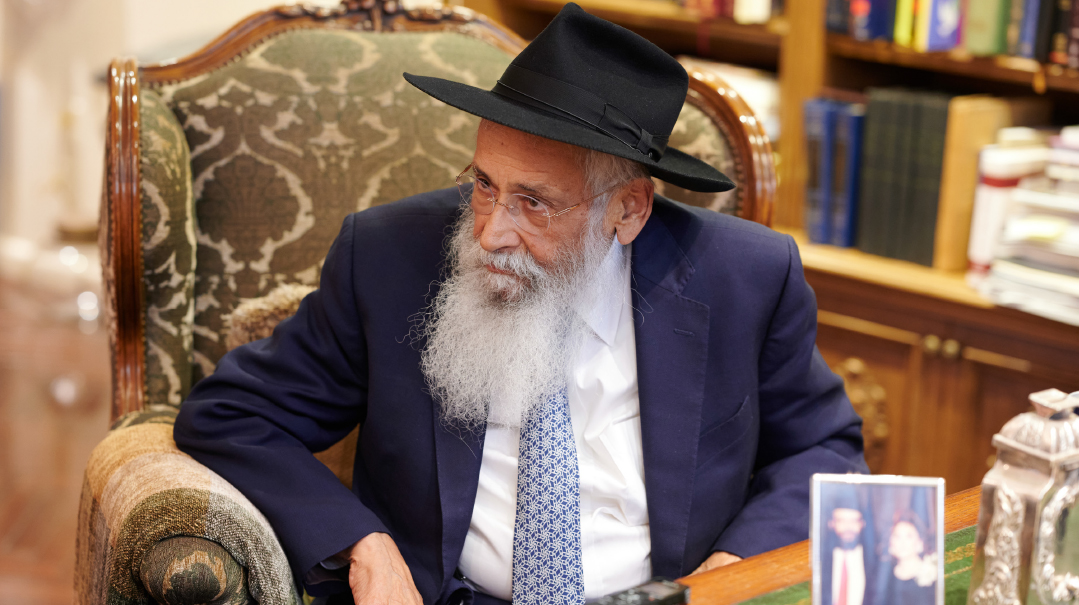
Rabbi Sholom Ber Lipskar: “No one has a heter to sit shivah. You don’t know until the last stone is picked up”
Until the Last Stone
The voices demanding there still be hope for discovering live people carried the day on Shabbos. Rabbi Lipskar’s psak was firm: As long as there are still rescue operations ongoing, one must not give up hope. No shivah. No yahrtzeit.
By the next day, though, the voices of dissent were more muted. And a visit to the site of the tower — a key demand by family members that was granted by Governor DeSantis that morning — was pivotal in providing closure.
“They were quiet, they said Tehillim, they davened,” said Mark Rosenberg. “People had argued that they should not be allowed to go to the site, saying that they would want to run all over the place, that they wouldn’t want to leave. But I can tell you — I was at all three tours, it was a closure for them.”
Rabbi Lipskar, 75, was the final arbiter for the many halachic issues that kept cropping up. The founder of The Shul in Bar Harbour, Surfside’s neighbor to the north, he presides over one of the largest Chabad shuls in the country. He is also the founder of the Aleph Institute, which advocates for inmates and works to ease prison life. Many members of his shul are among those missing.
His solution to the devastating crisis confronting his community, laid out in an address after Minchah on Sunday, was to increase in learning, davening, and tzedakah.
“Anybody who gives you a reason for this,” he told the crowd in his shul, which included Israel’s Diaspora Affairs Minister Nachman Shai, who arrived in a show of solidarity, “is either a fool or worse. Because there is no reason that can explain such a horrific thing like this.”
He also begged anyone who needed help to reach out.
“If you need any help, materially, spiritually, practically, emotionally, please don’t hesitate to reach out,” Rabbi Lipskar pleaded. “Members of the shul very much want to make sure you are performing at your best. If you need a phone, of if you need a vacation, just call. We have what it takes to help.”
The community then recited Avinu Malkeinu, with five people — relatives of three of the missing families — standing in front of the aron kodesh. Hundreds attended the service. A doctor in surgical scrubs sat in the back, schmoozing with Reb Volf Deitsch, the editor of Der Yid, a Yiddish-language newspaper in Williamsburg, vacationing with his family in Miami. A group of Lubavitchers were sprinkled throughout the crowd, while Rabbi Lipskar walked around, talking to this person and whispering to someone else. There are about 650 families affiliated with The Shul, about half of whom daven there regularly.
Rabbi Lipskar was intensely busy throughout the day, making repeated trips to the hotel where the families were located. “Rabbi, you’re needed for a couple who just came from Venezuela,” I overheard one volunteer telling him. He was also tasked with drawing up a Senate bill that would ease the family’s ability to perform kevurah if the situation warranted.
The questions that are coming before him now, he says, are “generational sh’eilos.”
“No one has a heter to sit shivah,” he says. “You don’t know until the last stone is picked up.”
He said that he received similar sh’eilos when a family belonging to his community was in the plane that crashed on September 11, 2001, into a field in Pennsylvania.
“It took weeks until they were able to sit shivah,” he recalls.
His wife, Rebbetzin Chana Lipskar, née Chein, was standing outside his office as I was walking out. I asked her where the shul’s generic name came from.
“Our shitah is that everyone should feel welcome,” she responded. “If someone were to walk in and ask, ‘Is this an Orthodox synagogue?’ Well, what is Orthodox? We want everyone to feel at home here.”
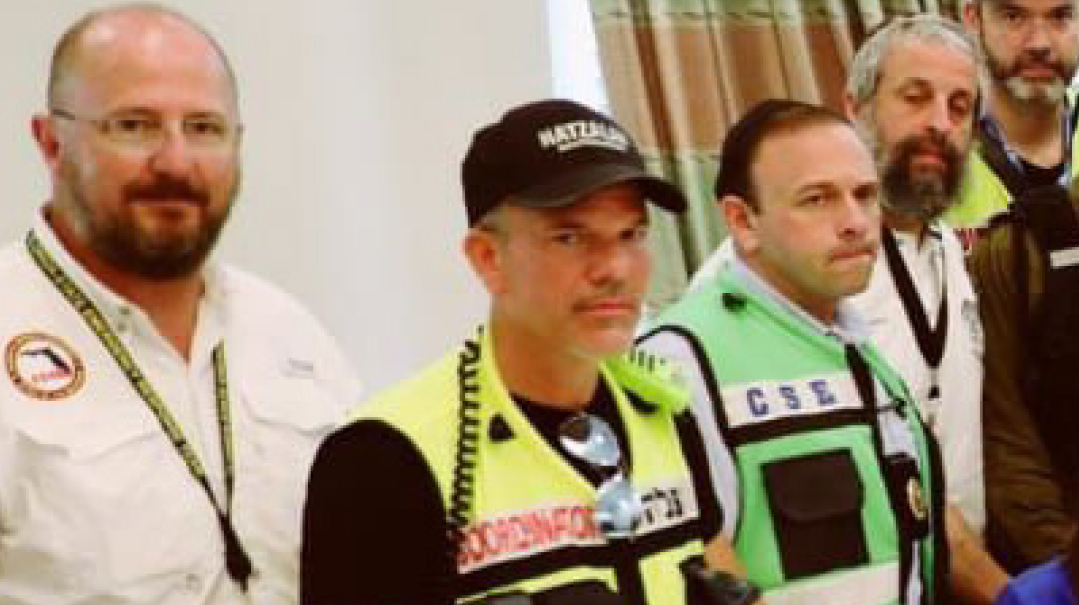
Baruch Sandhaus, CEO of Hatzalah of South Florida (center) describes a desperate search for survivors that continues around the clock, categorically rejecting the notion of any slowdown
What’s Taking So Long?
The issue as to whether workers were slow in beginning rescue work is a sore one among first responders. Yet 300 search and rescue agents have been working in teams around the clock since minutes after the building collapsed, according to Baruch Sandhaus, CEO of Hatzalah of South Florida, which received its state license to operate just one week before. Sandhaus himself has been on the scene since 1:15 Thursday morning. He describes a desperate search for survivors that continues 24 hours a day and categorically rejects talk of any slowdown.
“I brought Rabbi Lipskar to the scene at 2 a.m. on Shabbos morning,” Sandhaus says. “He stayed there for many hours, and he’s no youngster.”
At an atzeres tefillah on Sunday afternoon at his shul, Rabbi Lipskar named dozens of missing congregants, and he feels the pressure from the families.
The rumor that officials are slow-walking rescue operations has taken hold and is putting the families on edge. One mother confronted DeSantis when he visited on Shabbos, berating him for not putting more boots on the ground. When an official said that human remains had been found, a loud wailing erupted from the families and the woman stood up and demanded that DeSantis “do more” to extract their loved ones from the mountain of concrete.
“Imagine if your children were in there,” she told the governor. “You are going to leave here and you are going to take a nice picture. I know you are doing everything you can, but it’s not enough.”
Search and rescue teams have defended the slow pace. The crushing weight of 13 stories collapsing atop each other created a concrete pancake that may have allowed people to survive the impact by hiding in clefts; any movement by heavy equipment could eliminate that gap. Officials also say that fires have been erupting from combustible material left in the rubble, delaying their response. Thursday night also saw a drenching thunderstorm.
Workers in groups of 12 have been digging through the wreckage for a few minutes at a time due to the extreme Miami heat. The night hours, when the weather is a bit cooler, have allowed them to perform their work at a faster pace.
Early Sunday morning, the Florida Task Force Four arrived from Orlando, Israel’s Home Front Command landed in Miami, and a Jewish search and rescue team was dispatched from Mexico. They brought with them dogs trained to sniff out a pulse several feet below the ground, robots, drones, and sonar technology.
Moran Amar, who lives in Miami, said that her mother works for Israel’s foreign service, so she utilized her connections to get more searchers.
“I have friends in the building, and I saw that things weren’t moving,” Amar said. “I was desperate. I saw how desperate the families were, and just felt like I had to do something, to push a little harder. And baruch Hashem, the Israelis came today to assist.”
Chaya Hentchy Friedman, the trauma counselor, says the hardest part is not knowing.
“When you come into the unknown,” she says, “the grieving process can’t start. And there is nothing more aggravating for the nervous system than when your whole body is prepped with thinking that a person is still alive, and unfortunately you have to suppress that adrenaline. So this is a very volatile time for them.
“I’ve never been so humbled,” she added. “I usually think, ‘I can process things, I know the steps, I have a framework.’ But over here, HaKadosh Baruch Hu put me into a situation where I could not do anything. I saw raw shock and grief. I don’t think this is going to go away for a long time.”
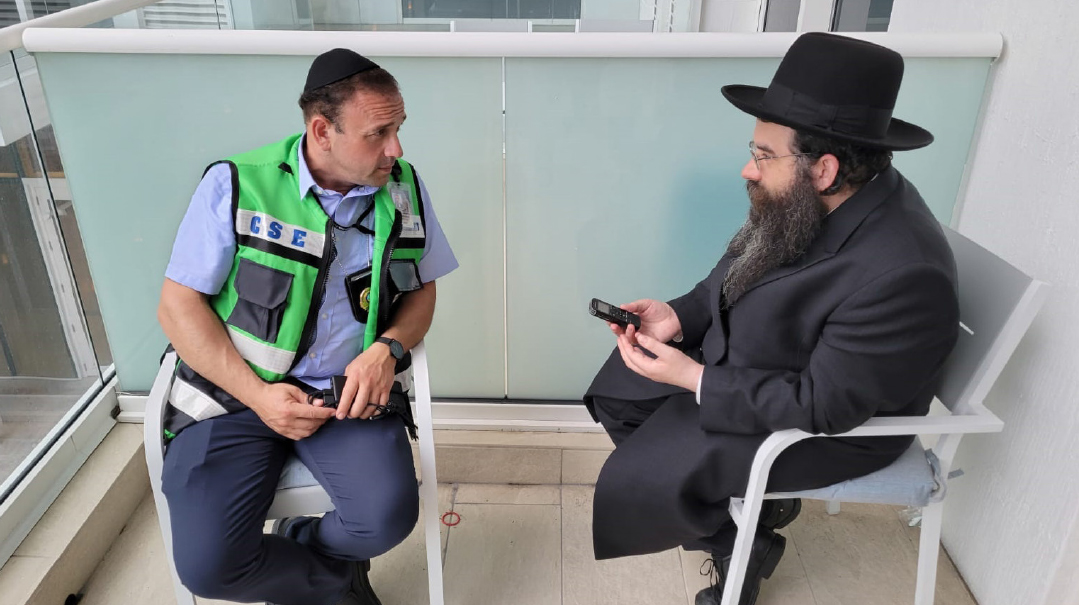
Rabbi Mark Rosenberg of Chesed Shel Emes. “People say, ‘Oh, you can handle it.’ But it doesn’t work that way”
The Path Forward
Based on experience with similar tragedies in the past, both Rabbi Lipskar and Mark Rosenberg expect that full closure will be months off. But relatives, still at the peak of their grief, have begun internalizing the bitter reality that only a miracle can reunite them with their family members.
“How many people did you find on Thursday?” one woman asked a searcher on Shabbos.
“None,” he responded.
“And what about on Friday?”
“None.”
“And today?”
“None,” came the distressing reply.
“Thank you,” the woman said quietly.
Hours later, at the second of the two daily briefings, the woman had a list of questions for the rav — about DNA, about when the yahrtzeit will be, about burial.
“Did he suffer?” one man repeatedly questioned at the briefing, oddly repeating, “I don’t care whether it’s the truth, I just want to hear the truth.”
Rosenberg recalled the chief of Miami police’s homicide division admitting that he could not handle the stress and broke down. “I can’t take it,” another police officer told Rosenberg, asking him for help in navigating the pain of facing so many loved ones waiting for the inevitable news.
“Who is cut out for this?” Rosenberg wondered. As a veteran of accidents that have left lifetime psychological scars, he recommends that families speak to mental health professionals.
“Many people avoid it,” he notes. “They say, ‘I think I’m okay.’ But by the time you realize you are not okay, you may not be in a position to go seek the help you need.”
Rosenberg says that his staff and Hatzalah members have handled the incomprehensible situation heroically only by using Herculean reservoirs of strength.
“People say, ‘Oh, you can handle it.’ It doesn’t work like that. You have to have the head space for it. If we are such caring people that we can handle hearing other people’s pain, how could it not affect us?”
(Originally featured in Mishpacha, Issue 867)
Oops! We could not locate your form.













